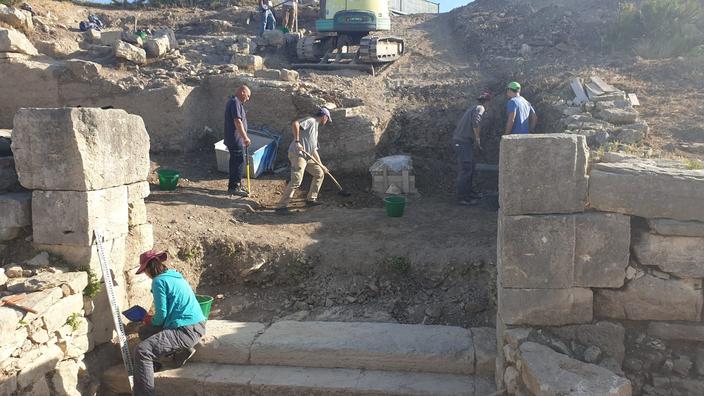Ancient Greek city on the western slope of Sicily, Segesta is known today for its unfinished 5th century Doric temple, which could have only been a magnificent peristyle, and for its theater leaning against the bucolic slope of Monte Barbaro, in front of which extends, in the distance, the Riviera spectacle of the Gulf of Castellammare.
To read also: Archeology: a "priceless treasure" of 27,400 pieces found at a French looter
Less known from postcards, what remains of the city's agora, on the other hand, goes much more unnoticed.
More surveyed by archaeologists than by visitors to the site, the public square of ancient Segesta was excavated in May by Italian researchers from the École normale supérieure and the University of Pisa, who discovered new remains there, among the most imposing ever unearthed in this part of the city.
Read also: An exceptional ancient theater discovered in Sicily
Archaeological excavations have been concentrated in the south of the agora of Segesta, where they have unearthed from Sicilian soil the lineaments of a public building. Dated from the 2nd or 1st century BC. BC, this vast structure faced the monumental portico which enclosed the square and whose construction had required major leveling works at the top of this acropolis. Only a small part of the building discovered has so far been cleared from the relief of Monte Barbaro, so that its precise function is still poorly identified and that new excavation campaigns should finish excavating. However, the Italian researchers did not fail to observe the good size of the blocks used, as well as their general similarity to those of the theater, located some 150 meters from the site.
1/2 - The base of the statue being cleared.
Scuola Normal Superiore di Pisa
2/2 - The base of the statue completely exhumed.
Parco Archeologico di Segesta / Beni Culturali
A repeat offender
Failing to be completed yet, the excavation site has delivered to archaeologists the remarkable discovery of a well-preserved statue base, which was located near the entrance to the building.
Not very exciting in normal times, the quadrangular block was here covered on its main face with an
elogium
, an honorary inscription celebrating the memory of a generous evergetist.
Nicknamed, Diodorus, son of Tittelo, this character had the memory of his act of evergetism engraved in stone, that is to say his civic and interested financing of one or more public monuments.
Inscribed in the Greek language, the text thus celebrates - in the midst of the addresses to the gods - the memory of Diodorus' father, who was to represent the statue.
This one is presented by his son as a gymnasium who had himself financed, in his time, the construction of a building for the youth of the city, probably a gymnasium, because of his title.
Read also: In the footsteps of Dionysius the Elder, the paranoid tyrant of Syracuse
Decidedly a very opulent and active figure of Segesta around the 2nd or 1st century BC. AD, the same Diodorus, son of Tittelo, was already known to archaeological services.
"He had erected the statue of his sister Urania, priestess of Aphrodite, which was found in the 17th century in the Doric temple
,
"
epigraphist Carmine Ampolo of the Pisa Normal School said in a statement. The happy discovery of a new inscription from Segesta thus illustrates once again the importance given to family ties and the filiation between two generations of the local aristocracy.
"These are very important results, which demonstrate the fundamental role played by the civic expenditure of large families in the history of ancient Sicily and the importance accorded to them in the most strategic places"
, said congratulated the director of excavation Anna Magnetto.
Difficult to compare with contemporary patronage actions, evergetism was a system generalized throughout the Greek and Roman world - with local adaptations - that historian Hervé Inglebert describes, using Paul Veyne's formula, as
"an aristocratic model aiming to obtain a civic consensus by an original use of the land rent surpluses
”. Placed in the entrance of the still mysterious edifice of the agora, at a strategic crossing point of a building in the city center, the statue financed by Diodorus, son of Tittelo was to be seen by all those entering the building. building, even those who passed just in front of it. The generosity of the Ancients had at least that in common with the current patronage: it was visible.

